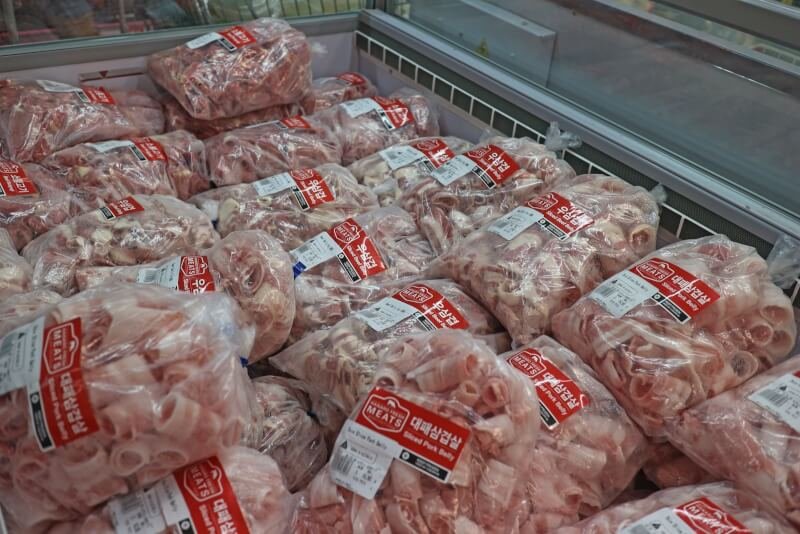Have you ever found yourself wondering just how long you can keep that package of meat in your refrigerator before it turns into a potential health hazard? Well, fear not! In this article, we will explore the answer to this age-old question by delving into the science behind refrigeration and examining the various factors that contribute to the spoilage of meat. By the end, you’ll have all the knowledge you need to ensure the freshness and safety of your meat supply, making your meal preparations worry-free and delicious. So, let’s get started and uncover the secrets to extending the shelf life of your meat!

Factors affecting the shelf life of refrigerated meat
When it comes to the shelf life of refrigerated meat, there are several key factors that can influence how long it stays fresh and safe to consume. These factors include the type of meat, packaging, storage temperature, and storage duration. By understanding these factors, you can ensure that your meat stays fresh and safe for as long as possible.
Type of meat
The type of meat you’re working with plays a significant role in determining its shelf life. Different types of meat have varying levels of fat content, which can impact how quickly it spoils. For example, beef tends to have a longer shelf life compared to pork or chicken. This is because beef has a lower fat content, making it less susceptible to spoilage. On the other hand, higher-fat meats like pork and chicken have a shorter shelf life and require more careful handling and storage.
Packaging
Proper packaging is crucial in extending the shelf life of refrigerated meat. When meat is exposed to air, it can lead to oxidation, which accelerates spoilage. To prevent this, it’s important to ensure that meat is tightly sealed in airtight packaging. This can be done using vacuum-sealed bags or wrapping the meat tightly in plastic wrap. Additionally, storing meat in leak-proof containers can help prevent any potential cross-contamination with other foods in the refrigerator.
Storage temperature
The storage temperature of refrigerated meat is another critical factor to consider. The ideal temperature for refrigerated meat is between 32°F (0°C) and 40°F (4°C). Keeping the temperature within this range slows down the growth of bacteria and helps maintain the quality of the meat. However, it’s important to note that the temperature in different areas of the refrigerator can vary. To ensure even cooling and maintain a consistent temperature, it’s best to store meat on the lower shelves, away from the door.
Storage duration
The length of time meat can be safely refrigerated before it goes bad depends on various factors, including the type of meat, packaging, and storage temperature. Generally, raw meat can be refrigerated for 1-2 days, while cooked meat can last 3-4 days in the refrigerator. It’s essential to use your judgment and inspect the meat for any signs of spoilage before consuming it. When in doubt, it’s best to err on the side of caution and dispose of any meat that appears to be spoiled.
Shelf life of refrigerated raw meat
Different types of raw meats have varying shelf lives when refrigerated. Here’s a breakdown of how long you can expect each type of raw meat to last in the refrigerator.
Beef
Refrigerated beef can typically last 3-5 days if properly stored. Ground beef, however, has a shorter shelf life and should be used within 1-2 days.
Pork
Pork is slightly more perishable than beef and should generally be consumed within 2-4 days when refrigerated.
Chicken
Chicken is one of the most perishable meats and should be consumed within 1-2 days when properly refrigerated.
Lamb
Refrigerated lamb can last 3-5 days, similar to beef. However, ground lamb should be consumed within 1-2 days.
Fish
When refrigerated, fish should be consumed within 1-2 days to ensure freshness and avoid the risk of spoilage.

Shelf life of refrigerated cooked meat
Once meat has been cooked, its shelf life is generally extended compared to raw meat. Here’s how long different types of cooked meat can last when refrigerated.
Beef
Cooked beef can typically last 3-4 days when refrigerated, depending on the specific cut and how it was cooked.
Pork
Similar to cooked beef, cooked pork can last 3-4 days when refrigerated. However, it’s important to note that ground pork has a shorter shelf life and should be consumed within 1-2 days.
Chicken
Cooked chicken should be consumed within 3-4 days when refrigerated. It’s crucial to handle and store cooked chicken properly to avoid any risk of bacterial growth.
Lamb
Refrigerated cooked lamb has a similar shelf life to cooked beef and pork, lasting around 3-4 days.
Fish
Cooked fish should generally be consumed within 2-3 days to maintain its quality and taste. It’s important to note that some types of fish, such as tuna or salmon, may last longer when refrigerated.
Signs of spoiled meat
No matter how well you store your meat, there’s always a chance that it could spoil. Here are some signs to look out for to determine if your meat has gone bad.
Odor
Spoiled meat often emits a foul and unpleasant odor. If your meat smells off, sour, or has a strong, unpleasant odor, it’s a clear indication that it has spoiled and should be discarded.
Color changes
Fresh meat typically has a vibrant and uniform color. When meat begins to spoil, it may develop gray or greenish hues. If you notice any significant color changes, it’s best to avoid consuming the meat.
Texture changes
Spoiled meat can have a slimy or sticky texture when touched. If the meat feels slimy or tacky, it’s a sign that it has begun to spoil.
Sliminess
Sliminess is often a result of bacterial growth on the surface of the meat. If your meat feels excessively slimy or sticky, it is a strong indication that it has spoiled and should not be consumed.
Presence of mold
The presence of mold on meat is a definite sign of spoilage. Mold can appear as fuzzy patches or discoloration on the surface of the meat. Any meat with visible mold should be discarded immediately.

Storage tips to prolong meat’s freshness
To ensure the maximum freshness and longevity of your meat, follow these storage tips:
Proper packaging
Package your meat properly to prevent exposure to air and the potential for cross-contamination. Vacuum-sealed bags, airtight containers, or tightly wrapped plastic wrap are effective ways to keep your meat fresh.
Appropriate storage temperature
Maintain a temperature between 32°F (0°C) and 40°F (4°C) in the refrigerator to slow down bacterial growth and maintain the quality of the meat.
Keeping meat separate
Store different types of meat separately to avoid any potential cross-contamination. This prevents the spread of bacteria and helps preserve the quality of each individual meat.
Avoiding cross-contamination
To minimize the risk of cross-contamination, store meat on lower shelves of the refrigerator, away from ready-to-eat foods. Raw meat should never come into contact with cooked or ready-to-eat foods.
Using meat within recommended timeframes
To ensure the freshness and safety of your meat, it’s crucial to use it within the recommended timeframes. Be mindful of the shelf life limits mentioned earlier and plan your meals accordingly.
Guidelines for refrigerating meat
Here are specific guidelines for refrigerating different types of meat to ensure their optimal storage:
Beef
Refrigerate beef promptly after purchasing or cooking. Store it in an airtight container or wrap it tightly in plastic wrap. Ensure that the temperature in the refrigerator remains between 32°F (0°C) and 40°F (4°C).
Pork
Refrigerate pork within two hours of purchase or cooking. Store it in an airtight container or wrap it tightly in plastic wrap. Keep the temperature in the refrigerator between 32°F (0°C) and 40°F (4°C).
Chicken
Refrigerate chicken immediately after purchasing or cooking. Store it in an airtight container or wrap it tightly in plastic wrap. It is crucial to keep the temperature in the refrigerator between 32°F (0°C) and 40°F (4°C).
Lamb
Refrigerate lamb within two hours of purchase or cooking. Store it in an airtight container or wrap it tightly in plastic wrap. Maintain the temperature in the refrigerator between 32°F (0°C) and 40°F (4°C).
Fish
Refrigerate fish promptly after purchase. Store it in an airtight container or wrap it tightly in plastic wrap to prevent odor transfer. Keep the temperature in the refrigerator between 32°F (0°C) and 40°F (4°C).

Freezing meat for extended storage
If you’re unable to consume your meat within the recommended refrigeration timeframe, freezing it is a great way to extend its storage life. Here are some proper freezing techniques and recommended storage durations:
Proper freezing techniques
Ensure that your meat is properly prepared for freezing by packaging it in an airtight container or wrapping it tightly in freezer-safe materials such as freezer wrap or heavy-duty aluminum foil. Remove as much air as possible to minimize freezer burn.
Recommended storage durations
For best quality, frozen meat should ideally be consumed within 3-6 months for red meats like beef, pork, and lamb. Poultry and fish can be kept for slightly shorter durations, ideally within 2-3 months.
Handling thawed meat
When thawing frozen meat, it’s important to handle it properly to maintain its safety and quality. Here are some guidelines for handling thawed meat:
Cooking immediately
Once meat is thawed, it should be cooked promptly to avoid any bacterial growth. Avoid leaving thawed meat at room temperature for an extended period and cook it within a couple of hours.
Determining safety through smell and appearance
Before cooking thawed meat, assess its safety by smelling and inspecting its appearance. If the meat has an off or unpleasant odor, or if there are any significant color changes or texture abnormalities, it’s best to discard it.
Refreezing considerations
Once meat has been thawed, it should not be refrozen unless it has been cooked. Refreezing thawed meat can affect its texture and potentially impact its safety and quality.
Importance of following storage guidelines
Following proper storage guidelines for refrigerated meat is essential for a variety of reasons:
Preventing foodborne illnesses
Storing meat at the correct temperature and following recommended timeframes helps prevent the growth of bacteria that can cause foodborne illnesses. By reducing the risk of bacterial contamination, you can keep yourself and your loved ones safe.
Avoiding food waste
Proper storage techniques ensure that meat stays fresh for as long as possible, reducing the likelihood of it going to waste. By maximizing the shelf life of your meat, you can minimize food waste and save money.
Maintaining meat quality
By storing meat correctly, you can maintain its quality and taste. Proper packaging, appropriate storage temperature, and timely consumption all contribute to preserving the freshness and flavor of your meat.
In summary, understanding the factors that affect the shelf life of refrigerated meat, knowing how long different types of meat can last, recognizing signs of spoilage, following proper storage tips, and adhering to recommended guidelines for refrigerating, freezing, and handling meat are all crucial steps in ensuring the freshness, safety, and quality of the meat you consume. By taking these measures, you can enjoy your meat while minimizing the risk of foodborne illnesses, reducing food waste, and preserving meat’s optimal taste and texture.


